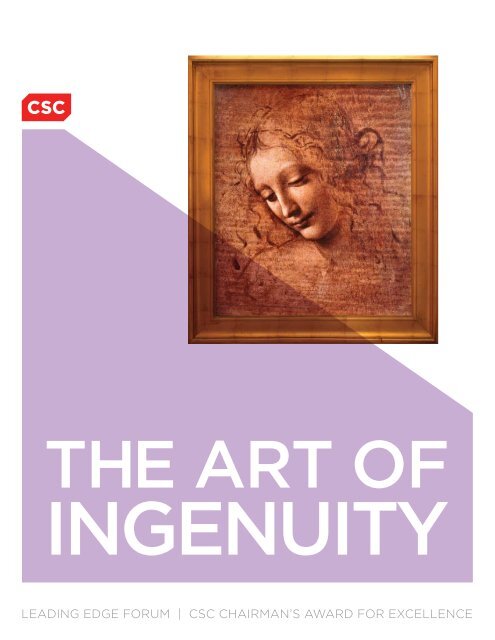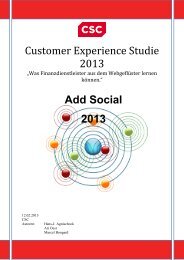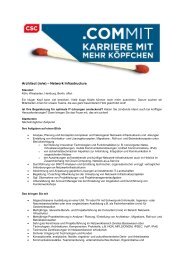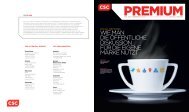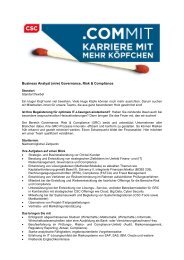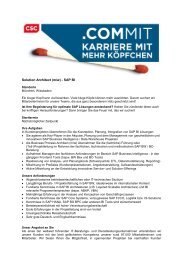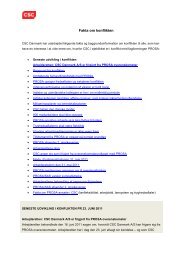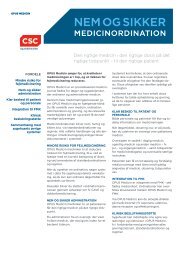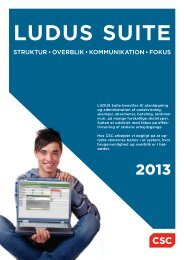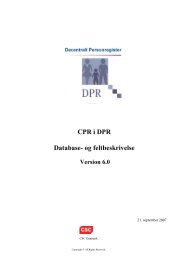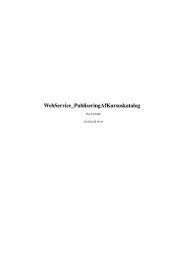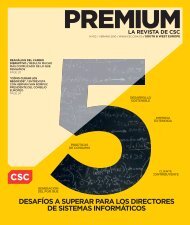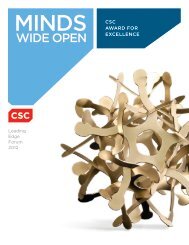Chairman Award Brochure Front 2009 ver1.0.indd - CSC
Chairman Award Brochure Front 2009 ver1.0.indd - CSC
Chairman Award Brochure Front 2009 ver1.0.indd - CSC
Create successful ePaper yourself
Turn your PDF publications into a flip-book with our unique Google optimized e-Paper software.
THE ART OF<br />
INGENUITY<br />
LEADING EDGE FORUM | <strong>CSC</strong> CHAIRMAN’S AWARD FOR EXCELLENCE1
FOREWARD
2010 <strong>CSC</strong><br />
CHAIRMAN’S AWARD FOR<br />
EXCELLENCE<br />
Our purpose is clear: To deliver innovative<br />
business and technology solutions that help<br />
our customers around the world achieve<br />
meaningful results for their business. The <strong>CSC</strong><br />
<strong>Chairman</strong>’s <strong>Award</strong> for Excellence is a tribute<br />
to talent, skill and ingenuity.<br />
In these turbulent times, organizations must<br />
get the most out of their IT investments<br />
to achieve their goals. By staying abreast<br />
of emerging technologies and quickly<br />
deploying innovative solutions, organizations<br />
can remain competitive. Our success as a<br />
company comes from the contributions of our<br />
employees to help clients accomplish their<br />
business goals during both good and bad<br />
economic times.<br />
Presented annually, the <strong>Chairman</strong>’s <strong>Award</strong><br />
honors those individuals and teams that have<br />
significantly advanced our clients’ business,<br />
or our own, through innovative solutions that<br />
realize maximum benefit for organizations and<br />
their shareholders.<br />
Recognizing such vital contributors is a core<br />
value of our company. Even though only a<br />
select few receive the award, the motivation<br />
and desire for excellence that it inspires reach<br />
throughout the corporation. These individuals<br />
represent all that makes <strong>CSC</strong> a great<br />
company. Join me in paying tribute to them<br />
and thanking them for their contributions.<br />
Michael W. Laphen<br />
<strong>Chairman</strong>, President and CEO
LEADING EDGE FORUM | CHAIRMAN’S AWARD FOR EXCELLENCE<br />
ABOUT THE <strong>CSC</strong> CHAIRMAN’S<br />
AWARD FOR EXCELLENCE<br />
The <strong>Chairman</strong>’s <strong>Award</strong> for Excellence is the most prestigious honor for <strong>CSC</strong> employees.<br />
It is given each year to recognize people who deliver solutions and services that<br />
demonstrate the highest levels of innovation and value to customers across our<br />
numerous industries.<br />
The criteria for the award mirror the principles we apply to every client engagement:<br />
Innovation — Use technology in creative and unique ways<br />
Leverage — Repeat what we’ve learned to other domains<br />
Proven — Deliver solutions that work<br />
Value — Create qualitative and quantitative value for our clients<br />
Hundreds of achievements have been nominated for the award over its history,<br />
representing the work of thousands of top-flight technology and business specialists.<br />
The select few projects that are chosen each year to receive the award truly are best in<br />
class.<br />
This year six <strong>CSC</strong> teams behind ground-breaking achievements in the transportation,<br />
technology and consumer, and public sectors are this year’s recipeints of the 2010 <strong>CSC</strong><br />
<strong>Chairman</strong>’s <strong>Award</strong> for Excellence.<br />
2
Recipients<br />
2010 <strong>CSC</strong> CHAIRMAN’S<br />
AWARD FOR EXCELLENCE<br />
Finalists<br />
2010 <strong>CSC</strong> CHAIRMAN’S<br />
AWARD FOR EXCELLENCE<br />
CONTENTS<br />
Applying Innovative Software Processes to the Hubble Space Telescope Repair<br />
I-MING (ANNIE) CHIEN, DENNIS P. GARLAND, MICHAEL KELLY, WENDY LINDBOE .............4<br />
Automation of Land Registration in Denmark<br />
ULLA TONNE BECH, HANS L. JAYATISSA, HENRIK KORSBÆK, CLAUS LJUNGGREN ..........6<br />
Eco Orange: Turning a Recycling Program into a New Customer Offering<br />
JEAN-VINCENT CAZAUX, OLIVIER DOUVILLE, MARYNA FEDRIGO, SÉBASTIEN MARIE ....8<br />
An Internet Transformation Program Positions Fnac.com as the Leading Web Merchant<br />
in France<br />
LAURENT ATLANI, FRÉDÉRIC BOUIN, ALI HAGHIPOUR, JOSEPH TEMPIER ............................10<br />
Launching NASA/JPL into the Cloud<br />
VIRINDER DHILLON, J. NEIL KRONIMUS, TODD LUCAS, JOSEPH MARPHIS ............................. 12<br />
Swiss Rail Control System: High Availability to Increase Network Capacity and<br />
Punctuality<br />
FRÉDÉRIC AUBERSON, GILLES IACHELINI, MATTHIAS KRISTA, BENEDIKT SOOM ..............14<br />
C3: Connect, Communicate, Collaborate<br />
JOHN CHAMBERS, CLAIRE FLANAGAN, DON HENN, JOHN MACIOCI ........................................ 16<br />
Cash Management FutureScope: Improving an Organization’s Agility<br />
MICHAEL ARBEN, GEORGE SIMPSON ............................................................................................................ 16<br />
<strong>CSC</strong> Dynamic Desktop — More than just Desktop Virtualization<br />
TREVOR COLLINS, STEPHEN JEFFERS ......................................................................................................... 17<br />
<strong>CSC</strong> Dynamic Server — A More Efficient Deployment Process<br />
HUGH BROOKS, JOHN CAMPBELL, GABE D. KAZARIAN, BRIAN POAD .................................... 18<br />
Enterprise Security Roadmap: Protecting What Matters<br />
CHAD ALPERT, GORDON ARCHIBALD .......................................................................................................... 19<br />
Facilitating a Flexible and Secure Enterprise<br />
PAUL CASTRO ............................................................................................................................................................20<br />
Product Lifecycle Management Plus<br />
MICHAEL A. HAYES, MICHAEL LITTRELL, N. THOMAS MILLER, BRENT MYERS ..................... 21<br />
Project Plus: Ensuring CMMI Process Compliance<br />
AMIT BALWANI, HARSH TIKKU ......................................................................................................................... 22<br />
SOX Compliance at Large German Bank<br />
MICHAEL MARKIEWICZ ......................................................................................................................................... 22<br />
STEALTH 3000: ERP for the Fashion Industry<br />
ANGELO CALABRESE, NANCY CHAPMAN, NICOLETTA CREMONESE,<br />
CHARLES TROYER ................................................................................................................................................... 23<br />
Past <strong>Award</strong> Recipients ...........................................................................................................................................26<br />
3
RECIPIENTS<br />
LEADING EDGE FORUM | CHAIRMAN’S AWARD FOR EXCELLENCE<br />
APPLYING INNOVATIVE SOFTWARE<br />
PROCESSES TO THE HUBBLE SPACE<br />
TELESCOPE REPAIR<br />
<strong>CSC</strong> software engineering played an<br />
important role in the repair of the Hubble<br />
Space Telescope (HST), thus restoring the<br />
flow of fantastic images of the cosmos and<br />
contributing to mankind’s never-ending<br />
quest to explore and understand the galaxy.<br />
HST’s flagship camera, the Advanced<br />
Camera for Surveys (ACS), suffered a<br />
power failure in January 2007, making ACS<br />
inoperable. In concert with the full ACS-<br />
Repair team, the <strong>CSC</strong> ACS-R Operations<br />
Team designed, developed and tested the<br />
flight software needed for the repair, which<br />
was the first on-orbit board-level repair by a<br />
NASA crew, successfully performed in May<br />
<strong>2009</strong>.<br />
The ACS repair was added to the already<br />
I-Ming (Annie) Chien, Dennis P. Garland, Wendy Lindboe, Michael Kelly<br />
planned Service Mission 4 (SM4), scheduled<br />
to launch in May <strong>2009</strong>. To meet the SM4<br />
deadlines, the <strong>CSC</strong> team, based at NASA Goddard Space Flight Center, designed, developed<br />
and tested the software in eight months, a dramatically compressed schedule with no room<br />
for error. Further, two new instruments being installed as part of SM4 had been designed to<br />
complement ACS, elevating the need for a flawless repair.<br />
Rapid Approach<br />
The <strong>CSC</strong> team innovatively applied well-established software processes to what was originally<br />
viewed as a hardware problem. The team modified the processes, changing from the traditional<br />
waterfall model that historically has been used for flight software to a rapid prototyping<br />
approach, enabling the team to meet the tight deadlines.<br />
A major part of the repair involved interfacing ACS to a new Teledyne application-specific<br />
integrated circuit (ASIC). The work also involved the integration and testing of field<br />
programmable gate array (FPGA) technology. ASICs and FPGAs represent an innovative<br />
advance in space flight hardware because, as programmable integrated circuits, they can<br />
replace custom hardware with software, which is much faster and less expensive to create<br />
(as ground applications have already seen). Hardware can be re-configured by software for<br />
a particular task. For example, the new James Webb Space Telescope (JWST), the successor<br />
to HST, is using the identical ASIC (hardware) but is uniquely programmed to interface with<br />
JWST’s science data detectors. The HST ASIC code is entirely different from that of JWST’s.<br />
4
The team treated the ASIC as a flight software change in order to verify its compliance with<br />
proven space flight system integration processes used at Goddard. This shortened the system<br />
integration effort significantly while ensuring quality. (All flight software changes are subjected<br />
to rigorous standards.)<br />
As a result of the combined efforts of the <strong>CSC</strong> team, the SM4 crew, and the scientists and<br />
engineers at the Space Telescope Science Institute and Goddard, ACS is now able to provide<br />
more than 80 percent of the scientific observations for which it was designed.<br />
With the return of ACS to scientific research, <strong>CSC</strong> has strengthened NASA’s reputation for<br />
innovation in the international science community and <strong>CSC</strong>’s reputation for excellence in<br />
mission-critical systems.<br />
5
Ulla Tonne Bech<br />
Hans L. Jayatissa<br />
AUTOMATION OF LAND REGISTRATION IN<br />
DENMARK<br />
For more than 450 years, Denmark used a paper-based system for land<br />
registration. It was time to digitize the process.<br />
Under the Danish Ministry of Justice, the Land Registry Court administers the<br />
registration of all rights on properties in Denmark (ownership, deeds, easements,<br />
mortgages, etc.), with a total property value of more than $20 billion USD. The<br />
system was time consuming, averaging two weeks processing time; managed<br />
a high volume (more than 5 million cases per year); and maintained an archive<br />
of 80 million paper documents. The information in the land registry books is<br />
legally binding and the Government of Denmark is liable and accountable for any<br />
mistakes.<br />
The objectives of the project were clear: modernize and improve efficiency by<br />
digitizing 100% of the process, automating 60-70% of the process within five<br />
years, reducing costs, and improving consistency.<br />
<strong>CSC</strong> Denmark developed eTL, the Danish digital land registry system. The system<br />
is an important part of a large IT ecosystem that supports the property sales and<br />
mortgage sector in Denmark. It integrates with a large number of public systems<br />
and the Danish PKI infrastructure to handle authentication and legal signatures.<br />
Based on an event-driven service-oriented architecture, eTL uses secure Web<br />
services for its internal and external portals to address the needs of its many<br />
stakeholders (caseworkers, citizens, financial institutions).<br />
In designing the system, <strong>CSC</strong> developers kept the architecture simple, creating<br />
a system that was easy to deploy as well as maintain. eTL is built almost entirely<br />
on open source technologies on the Java/JEE platform using Oracle application<br />
server and database. Through agile principles and a test-driven approach, the<br />
team delivered consistently high-quality code.<br />
The workhorse of eTL is its core engine that automates legal processing. Danish<br />
land registration is a very complex process, with 80 different types of cases.<br />
Consequently, 80 different manual paper-based processes had to be digitized<br />
and handled automatically. The core engine’s generic framework makes it<br />
possible to represent those 80 different processes (and any future processes)<br />
within one simple process pattern. Within eTL, each type of case is represented<br />
as an XML document and is run through a set of inspections to reach a legal<br />
judgment. If the XML document does not pass all the controls, the case is sent to<br />
the case officer portal for manual processing.<br />
Deployed in September <strong>2009</strong>, eTL has successfully met the project’s outlined<br />
objectives. With eTL’s automation, self-service features and reduced process<br />
time (many cases are decided in milliseconds), Danish citizens are able to<br />
register rights on properties themselves and avoid costly lawyer’s fees and the<br />
LEADING EDGE FORUM | CHAIRMAN’S AWARD FOR EXCELLENCE 6
Henrik Korsbæk<br />
Claus Ljunggren<br />
need for interim financing. With online access to a single source of land registry<br />
information, citizens can track a property they are interested in and receive alerts<br />
when events occur.<br />
To take advantage of eTL, the Danish financial sector created a central exchange<br />
hub, e-Nettet, to handle land registration data shared by the banks and eTL. eTL<br />
has enabled the financial sector, like Danish citizens, to be more self-sufficient,<br />
taking over certain work previously done by lawyers.<br />
With the eTL project, the Danish government has made a tremendous<br />
breakthrough in its global digitization strategy and has vastly improved service<br />
for its citizens.<br />
7
Jean-Vincent Cazaux<br />
Olivier Douville<br />
LEADING EDGE FORUM | CHAIRMAN’S AWARD FOR EXCELLENCE<br />
ECO ORANGE: TURNING A RECYCLING<br />
PROGRAM INTO A NEW CUSTOMER<br />
OFFERING<br />
How many old mobile phones do you have sitting in a drawer?<br />
Worldwide, it is reported that the majority of people keep their old mobile<br />
phones, even if they don’t use them.<br />
French telecommunications company Orange recognized this inefficiency as a<br />
huge opportunity. With <strong>CSC</strong>, it set out to transform its process for collecting<br />
old phones into a value generating, environmentally friendly proposition which<br />
could be compared to the French car buyback program for old cars. Its Eco<br />
Orange program, while providing a second life to devices such as mobile<br />
handsets, is helping to improve customer loyalty, increasing their purchasing<br />
power, providing eco-friendly benefits to the planet, and enabling developing<br />
countries to obtain inexpensive mobile phones. The customer benefit is either<br />
to pay less for a mobile replacement or to upgrade its mobile by choosing one<br />
from a superior category. As for Orange, it consists in improving the customers’<br />
satisfaction by offering a more attractive offer and improving the environmental<br />
performance without any impact on Orange margin.<br />
Eco Orange was developed within Orange Care, a new end-to-end portfolio of<br />
care services for customers; from the time they purchase a device to when they<br />
retire it.<br />
<strong>CSC</strong> designed the Eco Orange concept and managed its implementation. The<br />
concept was ground-breaking because Orange had never set up such a thorough<br />
reverse logistics process before; the program used a standardized system<br />
applicable to multiple countries (the program was launched in eight European<br />
countries simultaneously); and the process included the whole value chain.<br />
Orange was intent on being a leader and proving that new, inventive actions<br />
were possible on a massive scale. All told, Orange expects to realize millions in<br />
additional revenue annually from the program worldwide.<br />
Eco Orange: How It Works<br />
The Eco Orange concept is to collect old mobile phones and laptops from<br />
users, whether Orange customers or not. If the item is in poor condition, Orange<br />
recycles it. If the item is in good condition, Orange issues a credit, in the form of a<br />
voucher, that customers can use in Orange shops towards the purchase of a new<br />
mobile phone or any other item in the shop.<br />
The voucher is key to the program, because it gets people into an Orange store<br />
to buy, often spending 20% more than the amount of the voucher and up to 3<br />
times the amount of the voucher.<br />
Here’s how it works. First a person gets an estimate of the value of their phone<br />
on the Orange Web site, which produces a voucher estimate. Then he or she<br />
8
Maryna Fedrigo<br />
Sébastien Marie<br />
goes into an Orange store or franchise and gives the phone and estimate to a<br />
sales person, who verifies the condition of the phone and issues a real voucher.<br />
The voucher can be used like cash in any Orange store or franchise and is good<br />
for several months. If you buy a 50€ phone and have a 30€ voucher, you simply<br />
pay the 20€ difference.<br />
The old phone is either recycled (taken apart and parts sold) or, if in good<br />
condition, refurbished and resold. Money from parts sold goes to charities like<br />
UNICEF and the World Wildlife Fund. Refurbished phones are sold to developing<br />
countries through brokers.<br />
Orange established a partnership with third parties for the refurbishment and the<br />
reverse logistics flow, so as to test and sort the old devices as well as assess their<br />
value and oversee refurbishment operations.<br />
Eco Orange combines economic efficiency, social equity and environmental<br />
protection in a sustainable business model. The solution can be applied in any<br />
country with minimal modifications; it can be extended to other telcos, the retail<br />
sector, and organizations that have products that can be recycled.<br />
Today Orange is actively encouraging people to recycle. As well, Orange now<br />
sells second-hand mobile phones, a new market that can be extended to other<br />
devices (e.g., PC cards, PDA, netbooks).<br />
With Orange, <strong>CSC</strong> has shown how to turn a recycling necessity into a successful<br />
business invention.<br />
9
Laurent Atlani<br />
Frédéric Bouin<br />
AN INTERNET TRANSFORMATION<br />
PROGRAM POSITIONS FNAC.COM AS THE<br />
LEADING WEB MERCHANT IN FRANCE<br />
French retail giant FNAC, which sells CDs, DVDs, books, computers, cameras<br />
and other cultural and technical products, faced economic and market pressure<br />
to have a stronger online presence. FNAC wanted its online shoppers to benefit<br />
from what was best in its brick-and-mortar stores: sales expertise and customer<br />
service.<br />
In 2007, FNAC turned to <strong>CSC</strong> to help design and implement an Internet<br />
transformation program. <strong>CSC</strong> had already helped FNAC build and launch its<br />
online music distribution service on Fnac.com in 2004. Now, the transformation<br />
program would leverage synergies between FNAC’s 149 stores and Fnac.com.<br />
The three-year program has positioned Fnac.com as the leading Web merchant<br />
in France in terms of traffic, with an average of 750,000 internet users per<br />
day, and as one of the most profitable and innovative players in the European<br />
e-commerce landscape.<br />
Three-Pronged Approach<br />
The transformation program had three thrusts: a new business model based on<br />
an online marketplace strategy, the switch from product to customer-oriented,<br />
and international deployment.<br />
FNAC was the first non-pure-Web company in Europe to open an online<br />
marketplace for third-party sellers. Today some 6,500 sellers offer some 2.4<br />
million products on Fnac.com’s MarketPlace, which was launched in June <strong>2009</strong>.<br />
People can make purchases from the Web, a store or their mobile device.<br />
Because the Web captures a wealth of customer information that is difficult<br />
to gather in a physical store, such as recent research, shopping history and<br />
preferences, FNAC is harnessing this information to customize offers, promotions<br />
and recommendations on Fnac.com as well as enrich the customer’s in-store<br />
experience. To this end, My Fnac was launched on Fnac.com in October 2008<br />
to give customers a personalized experience and to enable FNAC to define<br />
customer segments and create targeted offerings.<br />
A key aspect of the transformation program is international expansion. An<br />
international platform was created from the French solution and rolled out<br />
to Italy, Spain and Portugal, with plans for additional country rollouts (Brazil,<br />
Belgium, Greece and Switzerland). The critical part was to design the core<br />
system to be plugged rapidly into any local logistics back office system, and to<br />
ensure that the new business processes were implemented appropriately. Italy,<br />
deployed in April <strong>2009</strong>, is reporting strong improvements in sales and order<br />
handling. Spain, deployed in August <strong>2009</strong>, is expected to realize strong benefits<br />
too.<br />
LEADING EDGE FORUM | CHAIRMAN’S AWARD FOR EXCELLENCE 10
Ali Haghipour<br />
Joseph Tempier<br />
Other key elements of the transformation program include NewRef, which<br />
modernizes product catalog management, and a new supply chain, called<br />
“100,000 products in 24h,” to handle expanded 24-hour delivery and seasonal<br />
spikes.<br />
11
Virinder Dhillon<br />
J. Neil Kronimus<br />
LEADING EDGE FORUM | CHAIRMAN’S AWARD FOR EXCELLENCE<br />
LAUNCHING NASA/JPL INTO THE CLOUD<br />
It’s a common problem many enterprises face: maxed-out data centers. NASA’s<br />
Jet Propulsion Laboratory (JPL) was out of data center space and <strong>CSC</strong> helped<br />
them determine that the cost of building a new 10,000-square-foot data center<br />
would be $40 million. JPL needed an alternative, cost-effective approach to keep<br />
up with continued exponential growth in computing demand.<br />
<strong>CSC</strong> had already led a virtualization effort at JPL to maximize the compute<br />
capacity of existing data center floor space; now it was time to take the next<br />
step, to cloud computing.<br />
JPL partnered with <strong>CSC</strong> to understand cloud computing and embark on a<br />
journey that has led to establishing JPL as a cloud leader in the U.S. federal<br />
government. The goal was to not only solve the compute capacity problem<br />
but do more with less, enabling more of JPL’s budget to be focused on NASA’s<br />
missions of space exploration and climate change research and less on IT.<br />
This was the first time <strong>CSC</strong> had undertaken a cloud project with the complexities<br />
of a NASA environment. The <strong>CSC</strong> team drew on extensive experience and<br />
expertise in technical architecture, design, engineering, networking and security<br />
to devise a secure way to handle a federal customer who needs to be compliant<br />
with the Federal Information Security Management Act (FISMA). As a result, <strong>CSC</strong><br />
successfully demonstrated the use of trusted clouds in the federal sector and<br />
created a cloud solution for federal clients.<br />
Cloud Journey<br />
<strong>CSC</strong>’s Trusted Cloud Services (powered by Terremark) provide JPL with<br />
compute, storage and network services. JPL is <strong>CSC</strong>’s first customer for the<br />
Trusted Cloud environment, a highly secure environment that meets JPL’s<br />
stringent security requirements. The cloud is flexible and fast, enabling JPL to<br />
provision servers in minutes with a few mouse clicks. JPL can be more responsive<br />
to business needs, and only pays for cloud services used (rather than incurring<br />
large up-front costs to buy its own computers).<br />
<strong>CSC</strong> worked with JPL to identify the approach for deploying applications in the<br />
cloud, including which applications to host and how to transition them. Two<br />
different application environments were migrated: a large transactional database<br />
from the Mars Science Laboratory mission and a Web development environment.<br />
The cloud solution for JPL was one of the first clouds to meet federal compliance<br />
regulations for security, reliability and transparency. In addition, it was one of<br />
the first community clouds built using VMware virtualization technology. This<br />
was significant because most clouds use Xen but most in-house enterprise data<br />
centers use VMware so using a VMware-based cloud facilitates migration from<br />
the enterprise data center to the cloud.<br />
12
Todd Lucas<br />
Joseph Marphis<br />
In addition, new capabilities were developed to: provide a secure virtual private<br />
network (VPN) connection between a community trusted cloud and private data<br />
center resources, enable cloud bursting into a trusted cloud, and use trusted<br />
cloud infrastructure as a disaster recovery site for continuity of operations<br />
planning.<br />
This debut cloud project with JPL positions <strong>CSC</strong> as a leader in cloud integration.<br />
Establishing JPL as a client in the Trusted Cloud leads the way for other<br />
organizations (federal or commercial) with stringent security regulations and<br />
compliance requirements to embrace cloud computing as a secure and reliable IT<br />
services paradigm.<br />
13
LEADING EDGE FORUM | CHAIRMAN’S AWARD FOR EXCELLENCE<br />
SWISS RAIL CONTROL SYSTEM: HIGH<br />
AVAILABILITY TO INCREASE NETWORK<br />
CAPACITY AND PUNCTUALITY<br />
Benedikt Soom, Frédéric Auberson, Matthias Krista, Gilles Iachelini<br />
A super-precise dispatching system, designed and implemented by SBB with the major<br />
contractor <strong>CSC</strong>, is fundamental for the Swiss railway to run like clockwork. Over a project<br />
period of 4½ years Rail Control System (RCS) has been developed by a team of about 100<br />
rail and technology experts on customer and IT provider side, with Matthias Krista, Benedikt<br />
Soom, Frédéric Auberson and Gilles Iachelini from <strong>CSC</strong> in key roles from architecture, business<br />
analytics to software implementation.<br />
RCS is a powerful solution for analyzing complex interactions between trains and providing<br />
accurate operational data to dispatchers fast, ultimately keeping trains on time and passengers<br />
happy.<br />
RCS provides near real-time information on the current operational status of approximately<br />
2,000 trains and 3,000 kilometers of track, switches and signals in the Swiss Federal Railways<br />
system. Overall punctuality has improved from 94 percent to 96 percent, making Switzerland<br />
the leader in international punctuality statistics.<br />
With RCS, timetables can be denser, allowing more throughput, and traffic forecasts are more<br />
accurate. This enables dispatchers to detect conflicts and re-route trains quickly. RCS is the<br />
only known system of its kind that manages extremely detailed data, for a network the size<br />
of the Swiss railway, using sophisticated algorithms that deliver data updates to dispatchers<br />
within one second.<br />
One of the chief innovations of RCS is more accurate forecasting. A specialized algorithm was<br />
devised for forecasting simultaneous train journeys for all trains, including a highly efficient<br />
method for calculating the network-wide impact of delays.<br />
The system receives and handles several hundred messages per second from different<br />
peripheral systems (e.g., timetables, train position sensors), processes these messages within<br />
a fraction of a second, calculates train journey forecasts, and delivers the resulting changes to<br />
hundreds of railway dispatchers and customer systems.<br />
14
To do this, RCS uses a fast, message-oriented architecture, data grid technology, and highspeed<br />
graphical user interfaces. Once messages from peripheral systems are received, they are<br />
forwarded to core server components, which handle several thousand messages per second.<br />
A temporal subset of the data is stored in an in-memory data grid. This unique design means<br />
that database queries can be substituted with high-performance object queries distributed<br />
across the grid. Queries are executed in parallel, improving performance by up to an order of<br />
magnitude versus a traditional database query. This “database on steroids” can be scaled up by<br />
simply adding compute servers at a fraction of the cost of an additional database server.<br />
Data reaches the dispatcher at a workplace consisting of eight high-resolution monitors. The<br />
java based application provides the main functions for train dispatching. Powering the monitors<br />
is done by the innovative client and graphical user interface (GUI) software that processes and<br />
displays data in near real time. The software displays the results of intensive parallel processing<br />
of detailed business data, such as track occupancy data and connection timetables, and<br />
redraws up to 18.4 million pixels per second.<br />
15
FINALISTS<br />
C3: CONNECT, COMMUNICATE, COLLABORATE<br />
John Chambers, Claire Flanagan, Don Henn, John Macioci<br />
When <strong>CSC</strong> launched its C3 social networking environment in <strong>2009</strong>, it spread like wildfire,<br />
attracting over 24,000 users worldwide in just 20 weeks. Today C3 is used by more than<br />
42,000 employees of our 92,000 employees and is expanding daily. <strong>CSC</strong>ers are breaking down<br />
time zones and corporate boundaries to get work done with others and to share ideas globally.<br />
We are better able to leverage our global expertise, meet or exceed customer needs, and act<br />
as “one <strong>CSC</strong>.”<br />
The C3 team applied what later became industry-recognized, award-winning adoption<br />
practices. Pledging to “think adoption, not deployment,” the team focused on a people-driven<br />
rather than technology-driven deployment. The team encouraged a flat application taxonomy,<br />
enabling employees to rally around any topic without organizational constraints. Because C3<br />
is completely self-service—organized, governed and moderated by employees—it can evolve<br />
naturally and adapt to employees’ needs.<br />
The team developed a powerful advocate program to further encourage and support global<br />
adoption. These advocates, dubbed “C3 Life Guards,” seeded C3 with content and groups<br />
before it was opened to the larger <strong>CSC</strong> organization. This created an enticing and nonthreatening<br />
environment for employees and led to C3’s viral adoption. The team also recruited<br />
executives and global account teams as early users, demonstrating C3 was “safe for business”<br />
and a tool for information exchange, team collaboration, and onboarding of new employees.<br />
C3 is built on the Jive SBS platform, a collaborative ecosystem (rather than a point solution)<br />
whose “bridging” capability enables the enterprise to serve many different markets<br />
(employees, customers, partners, project teams) but bridge the content, conversations and<br />
identity among them all.<br />
C3 is delivered as software-as-a-service to enable rapid system updates, and to implement<br />
Web content acceleration technology (Akami) to speed content delivery times by 60-80<br />
percent; pages display in three seconds or less. C3 operates globally but is as fast as if it were<br />
running locally.<br />
CASH MANAGEMENT FUTURESCOPE: IMPROVING AN<br />
ORGANIZATION’S AGILITY<br />
Michael Arben, George Simpson<br />
As companies turn to business intelligence and analytics to find new competitive advantages<br />
and improve decision-making, one fertile area is cash management. Improvements to cash<br />
management decisions go straight to the bottom line.<br />
LEADING EDGE FORUM | CHAIRMAN’S AWARD FOR EXCELLENCE<br />
16
Recognizing this, <strong>CSC</strong> developed an advanced analytics application for cash management<br />
called Cash Management FutureScope (CMF). CMF improves the ability of banks and large<br />
organizations to forecast their cash flow—the lifeblood of all businesses.<br />
Every day treasury departments need to forecast cash flows by drawing on information from<br />
all branches of an organization and then deciding what to do about the immediate surplus or<br />
shortage of cash. Current business intelligence and analytics products don’t go far enough;<br />
they focus on aggregating and presenting data in a useable form. CMF goes a step further,<br />
evaluating the likely consequences of different decisions on future cash flows.<br />
By showing how cash management decisions being considered either align with or contradict<br />
policy goals, CMF reduces the risk in cash management decisions. It increases earnings through<br />
more efficient cash management, reduces the risk of a cash shortfall, reduces the cost of<br />
borrowing, and frees up capital for other investments.<br />
The <strong>CSC</strong> team incorporated several innovations into CMF: use of historic data, policy-risk<br />
decision options, and non-parametric statistics.<br />
CMF extracts patterns from historical data based on transaction size and time, and applies<br />
these to the forecasting model to significantly improve cash flow forecast. In terms of policyrisk<br />
decisions, CMF allows users to explore their cash management decision options (borrowing<br />
or depositing and for how long) and presents the percentage risk that a policy will be violated<br />
in each option. By using non-parametric statistics instead of traditional parametric statistics<br />
(parametric statistics fit a model to past data such as a traditional bell curve), CMF avoids<br />
dangerous assumptions that could underestimate risk.<br />
In this way, CMF delivers higher reliability and lower risk with significant robustness and<br />
accuracy. CMF gives decision-makers the ability to compress time and see the likely future<br />
consequences of the different options they are considering.<br />
<strong>CSC</strong> DYNAMIC DESKTOP — MORE THAN JUST DESKTOP<br />
VIRTUALIZATION<br />
Trevor Collins, Stephen Jeffers<br />
Desktop management is still one of the most manual, time consuming and costly areas of<br />
IT. It is fraught with security concerns—the company’s applications and data are scattered<br />
all over—and environmental costs. However, it is now possible to overcome many of these<br />
issues through a combination of virtualization and secure access technologies to deliver highly<br />
flexible, personal desktop environments that can be accessed from anywhere. This solution is<br />
<strong>CSC</strong> Dynamic Desktop powered by Citrix and Microsoft.<br />
17
In use at several large companies representing tens of thousands of users, <strong>CSC</strong> Dynamic<br />
Desktop provides central management and improves business flexibility and security, while<br />
reducing the total cost of ownership and energy consumption of a company’s desktop<br />
environment.<br />
<strong>CSC</strong> Dynamic Desktop goes far beyond desktop virtualization, providing end-to-end service<br />
for deploying and supporting the desktop environment. It starts with a “service block” virtual<br />
desktop infrastructure, based on Citrix XenDesktop, offered in a desktop-as-a-service model.<br />
This service block includes virtual servers, storage, networks, applications, data, controls and<br />
services.<br />
Application virtualization is a key part of the solution. Applications are virtualized using a<br />
<strong>CSC</strong> service that assesses applications, determines which are suitable for virtualization, and<br />
virtualizes them using either Citrix XenApp or Microsoft App-V. Because applications are<br />
maintained centrally and linked to the user’s virtual desktop environment, not installed or run<br />
on the user’s end device, the user can access the environment from multiple locations and<br />
devices such as a laptop, netbook, PC, thin client, PDA, smart phone or iPad.<br />
Users can even get a “desktop on a stick,” whereby their desktop-access environment is on a<br />
USB stick drive they can plug into a public machine to create a trusted access environment to<br />
their secured virtual desktop. This is a great boon for mobile workers, who can essentially carry<br />
their desktop-access in their pocket and work from anywhere, securely and with the latest<br />
system updates.<br />
For more information, see www.csc.com/vds.<br />
<strong>CSC</strong> DYNAMIC SERVER — A MORE EFFICIENT DEPLOYMENT<br />
PROCESS<br />
Hugh Brooks, John Campbell, Gabe D. Kazarian, Brian Poad<br />
As businesses strive for speed, agility and efficiency, setting up computing systems quickly is<br />
paramount. <strong>CSC</strong> Dynamic Server does just that, enabling organizations to provision enterpriseready<br />
computing infrastructure with a few mouse clicks.<br />
Used to provide server, network and storage infrastructure as a service, <strong>CSC</strong> Dynamic Server<br />
results in an up to 90 percent more efficient deployment process and an average savings in<br />
total cost of ownership of 30 percent.<br />
But it’s not just about faster deployment; it’s also about faster integration. Integration that<br />
would typically take 6-7 weeks can be done in 2-3 days—a phenomenal improvement that<br />
translates to real business value for the enterprise.<br />
<strong>CSC</strong> Dynamic Server uses a high degree of automation, coupled with a Web-based<br />
service catalog, to eliminate up to 90 percent of the effort associated with deploying new<br />
LEADING EDGE FORUM | CHAIRMAN’S AWARD FOR EXCELLENCE<br />
18
infrastructure. The entire system life cycle—provision, modify and decommission—is automated<br />
at the touch of a button.<br />
By delivering infrastructure as virtualized services, <strong>CSC</strong> Dynamic Server enables significant cost<br />
savings. Its innovative design is over one-third more cost effective than traditional virtualization<br />
designs.<br />
<strong>CSC</strong> Dynamic Server supports a wide variety of virtualization platforms and operating systems.<br />
Automating different platforms under a standard umbrella is a powerful feature, made possible<br />
by a special multi-platform reservation system that <strong>CSC</strong> has developed.<br />
Catering to the enterprise, <strong>CSC</strong> Dynamic Server not only supports multiple platforms but also<br />
offers integrated customer service management for changing, configuring, monitoring,a and<br />
backing up infrastructure.<br />
<strong>CSC</strong> Dynamic Server furthers our commitment to cost-effective, practical, inventive solutions<br />
that address organizations’ most pressing business needs. As well, it contributes to the Green<br />
IT agenda by enabling organizations to minimize their space, power and cooling needs.<br />
For more information, see www.csc.com/dynamicserver.<br />
ENTERPRISE SECURITY ROADMAP: PROTECTING WHAT<br />
MATTERS<br />
Chad Alpert, Gordon Archibald<br />
Regulatory compliance, business continuity, and security threats—these are hot-button<br />
protection areas all organizations need to address. But how do you balance optimal security<br />
with the right level of investment for your business?<br />
<strong>CSC</strong>’s Enterprise Security Roadmap (ESR) does just that, treating IT security as a strategic<br />
business element. ESR helps clients make strategic decisions regarding IT security spending<br />
and prioritization while ensuring close business alignment and optimal investment. The solution<br />
answers key business questions about exposure areas, prioritization of security spending for<br />
maximum ROI, and the value and suitability of IT security and information risk for the business.<br />
ESR consists of four phases—current state assessment, enterprise security architecture,<br />
security strategy and roadmap development, and migration plan—and can be scaled as<br />
needed. Examined against ISO 27001 security standard objectives, ESR identifies key risks<br />
and IT security threats. ESR creates a logical depiction of the organization’s IT security model<br />
and identifies interoperating controls and objectives. A security strategy and roadmap is then<br />
developed and key remediation projects along with project criteria such as cost and impact are<br />
identified.<br />
19
The result: a 1-, 3- and 5-year organization objective and end-state roadmap. With this plan,<br />
organizations have a baseline and can track and manage organizational change over time.<br />
IT security is often looked at in terms of IT products and services. ESR includes the Threat<br />
Matrix, a tool that focuses on the value technology products and services bring to the<br />
organization. ESR removes the subjectivity and assesses the organization’s risks and<br />
appropriate mitigation solutions quickly and effectively.<br />
ESR provides organizations with an IT security strategy that is pragmatic and aligned with<br />
their business. The management team is able to articulate and demonstrate a measurable and<br />
defensible IT security strategy that provides the right balance of security investment and risk<br />
mitigation.<br />
FACILITATING A FLEXIBLE AND SECURE ENTERPRISE<br />
Paul Castro<br />
<strong>CSC</strong> kicked off a national blood drive campaign at one of its locations in July <strong>2009</strong>. Behind<br />
the scenes, organizers needed to make the registration process easy and fast. Utilizing a new<br />
wireless network, organizers were able to set up additional registration areas outside the <strong>CSC</strong><br />
building and enter and leave without losing their connection.<br />
The connectivity making this possible is a flexible, highly secure wireless infrastructure that<br />
enables employees and guests to connect to the Internet or <strong>CSC</strong>’s internal network from<br />
anywhere on the <strong>CSC</strong> campus. With our solution, traditional enterprise campuses, from<br />
hospitals to corporations to government agencies, can safely go wireless and go mobile.<br />
The new network provides robust, highly secure connectivity, enabling teams to come together<br />
quickly and collaborate, and boosting employee productivity as workers move around offices,<br />
floors and buildings and stay connected. Team rooms can be set up in minutes. <strong>CSC</strong> found<br />
that, on average, wireless users stay connected 55 minutes longer per day.<br />
The solution, which supports standard and high-speed Wi-Fi (802.11a/b/g/n), follows wireless<br />
best practices and meets stringent U.S. Department of Defense security requirements. The<br />
solution provides rogue detection and mitigation, over-the-air threat detection, performance<br />
monitoring and self-healing, proactive threat prevention, and security and compliance<br />
reporting.<br />
Other key design features include centralized management, yielding better visibility and control<br />
of the air space, and a building-block approach to add locations easily.<br />
In addition to improved productivity, collaboration and security, the solution delivers significant<br />
administrative savings. For a healthcare provider, we deployed the wireless solution as the<br />
LEADING EDGE FORUM | CHAIRMAN’S AWARD FOR EXCELLENCE<br />
20
foundation for voice-activated badges that physicians and nurses use to communicate with<br />
each other, tablet PCs physicians use to access patient records, and Internet access for<br />
patients.<br />
PRODUCT LIFECYCLE MANAGEMENT PLUS<br />
Michael A. Hayes , Michael Littrell, N. Thomas Miller, Brent Myers<br />
When a massive earthquake struck Haiti in January, the U.S. Army sent troops and supplies<br />
immediately. Thanks to an advanced data management system by <strong>CSC</strong>, Product Lifecycle<br />
Management Plus (PLM+), supplies reached Haiti before the first Army units arrived.<br />
The U.S. Army operates the largest, most complex supply chain and logistics organization in<br />
the world. Its logistics systems manage millions of materials, hundreds of millions of items in<br />
inventory, millions of customers and vendors covering 38 countries worldwide. Data sharing<br />
and process integration have always posed a challenge.<br />
PLM+ meets warfighter needs on demand by automating processes and ensuring that missioncritical<br />
data is clean, accurate and relevant.<br />
Prior to PLM+, master data management was decentralized, paper-driven, labor intensive<br />
and error-prone. The Army needed a solution that integrated internal and external systems,<br />
supported the entire supply chain, and provided a single infrastructure that could facilitate realtime<br />
decision making and the ability to link processes, systems and data anywhere, anytime,<br />
and in multiple formats.<br />
PLM+ addresses these needs by centralizing data management in an enterprise services hub,<br />
synchronizing master data across hundreds of Army and Department of Defense systems and<br />
improving data accuracy to 95 percent or better.<br />
In addition to data management services, PLM+ provides tools to help streamline and improve<br />
business processes across the Army, leverageable and repeatable enterprise integration<br />
services that enable different systems to communicate with each other without requiring<br />
detailed knowledge of each other’s systems, and business intelligence services that include<br />
not only reporting and analysis but end-to-end business activity monitoring for mission-critical<br />
logistics processes, the first Army system to do so.<br />
As a result of PLM+, logistics processes are faster; critical materiel shipments are more accurate<br />
and reach the right field units quickly.<br />
Each day PLM+ helps increase the effectiveness of military personnel around the world. PLM+<br />
moves the Army closer to its vision of achieving a Single Army Enterprise.<br />
21
PROJECT PLUS: ENSURING CMMI PROCESS COMPLIANCE<br />
Amit Balwani, Harsh Tikku<br />
Software development projects can be large, complex and somewhat of an art form. So how<br />
do you get everyone to follow best-in-class processes? How can you analyze project data<br />
systematically to look for improvements?<br />
To address these issues, <strong>CSC</strong> created Project Plus, a project management toolset for software<br />
development that delivers engineering excellence and business benefits. Project Plus<br />
enables software development organizations to achieve the highly respected CMMI-Level 5<br />
certification, the highest level of the Software Engineering Institute’s CMMI (Capability Maturity<br />
Model Integration) process model for software development.<br />
With Project Plus, one of <strong>CSC</strong>’s largest business units achieved CMMI Level 5 certification<br />
and is now being used in over 400 projects. It has improved on-time delivery and developer<br />
productivity; developers spend more time on value-adding tasks (development) and less time<br />
on administrative tasks (meetings/emails/putting together reports). Idle time (time waiting for<br />
a customer-related action) has dropped to less than one percent. These results come primarily<br />
from metrics-based management, a hallmark of Project Plus.<br />
Automation Drives Transparency and Continuous Improvement<br />
Project Plus uses intelligent automation to capture data that people otherwise don’t capture<br />
and use for analysis. Project Plus automates data capture, processing and analysis, enabling<br />
metrics on demand, to the level of detail needed, for management as well as customers.<br />
The wealth of data also facilitates continuous improvement across projects, programs and the<br />
business. Project Plus has the power to measure not only processes but sub-processes, where<br />
incremental improvements can be made.<br />
Project Plus is a complete workbench for the developer. In addition to program and project<br />
management and continuous improvement, it includes corrective and preventive actions,<br />
predictive actions, quality assurance and control, time tracking, and detailed dashboards and<br />
reporting at the project, group, program and division level.<br />
SOX COMPLIANCE AT LARGE GERMAN BANK<br />
Michael Markiewicz<br />
A major challenge facing most organizations is accurately identifying the people who access<br />
company data and systems. Identities and roles must be verified on an ongoing basis to ensure<br />
that only authorized personnel have access to only the resources they need. Although off-theshelf<br />
solutions exist, they often require substantial modifications and daily maintenance.<br />
LEADING EDGE FORUM | CHAIRMAN’S AWARD FOR EXCELLENCE<br />
22
This was the case at a large German bank, whose access governance software required perfect<br />
(i.e., error free) data but whose applications delivered imperfect data. The bank needed a<br />
process that could deliver perfect data on an ongoing basis.<br />
Horizon: The Art of Perfection<br />
The solution was Horizon, a clever application developed by <strong>CSC</strong> that bridges the gap between<br />
existing imperfect data and the perfect data needed for identity management and compliance<br />
solutions. Horizon rapidly processes and “cleans up” massive amounts of data without any<br />
manual intervention. It has been running flawlessly at the bank since June <strong>2009</strong>; because of it,<br />
the bank’s <strong>2009</strong> SOX recertification cycle was successfully completed.<br />
Horizon administers access rights for the bank’s 120,000 employees, extracting data from<br />
over 500 applications daily and processing over 3,000 changes in identity data, organizational<br />
structures and access rights daily. Using artificial intelligence and massively parallel processing,<br />
the solution performs its daily tasks in less than 30 minutes.<br />
Horizon applies artificial intelligence to compensate for inaccurate data in the applications.<br />
Instead of checking the formal correctness of a file, Horizon tries to read the information as<br />
a human would. With this approach, most files that would not pass a formal check can be<br />
processed successfully.<br />
Horizon features a powerful identity correlation engine that needs only milliseconds to identify<br />
an account owner. Even with sparse information, the system identifies account owners with<br />
better than 99 percent accuracy using a sophisticated matching and scoring method.<br />
STEALTH 3000 – ERP FOR THE FASHION INDUSTRY<br />
Angelo Calabrese, Nancy Chapman, Nicoletta Cremonese, Charles Troyer<br />
Nothing fits the fashion industry like STEALTH 3000.<br />
STEALTH 3000 is the secret that powers over 120 fashion companies. An enterprise-class<br />
ERP system for the apparel and footwear sector, STEALTH 3000 is the market leader in Italy.<br />
STEALTH 3000 balances the need for brand uniqueness with world-class business process<br />
efficiency.<br />
Fashion, by definition, means change. Entire product lines, representing tens of thousands<br />
of stock keeping units (SKUs), are recreated two to six times per year, meaning a very short<br />
shelf life and a highly dynamic global supply chain. For example, fabric can be purchased in<br />
Egypt, shipped to Turkey for dyeing and finishing, shipped to contract manufacturers in China<br />
for cutting and sewing, shipped to Italy or the United States for finishing, and shipped to final<br />
markets for sale. A single new style can define a completely new supply chain. Traditional<br />
enterprise software is typically a poor fit for such a volatile and complex environment.<br />
23
All of this complexity is neatly modeled in the STEALTH 3000 database, the heart of the<br />
system. <strong>CSC</strong> designed and developed the database to not only capture the complexity of the<br />
data relationships, but also to design in the flexibility that enables STEATLH 3000 to adapt to<br />
the unique and changing needs of each organization.<br />
The Web-enabled system supports multiple brands, companies, currencies and languages.<br />
“Flex-fields” are added to virtually all tables so organizations can define their own fields and<br />
menus. A flexible business rules engine lets organizations specify their own business logic and<br />
rules, and create and integrate custom functions.<br />
STEALTH 3000 transforms the economics of fashion companies, better matching supply<br />
to demand, lowering product costs through better controls, increasing inventory turns and<br />
reducing time-to-market.<br />
For more information, see www.csc.com/stealth.<br />
LEADING EDGE FORUM | CHAIRMAN’S AWARD FOR EXCELLENCE<br />
24
LEADING EDGE FORUM | <strong>CSC</strong> CHAIRMAN’S AWARD FOR EXCELLENCE 24
<strong>2009</strong><br />
A <strong>CSC</strong>-managed Mobility Service for<br />
Royal Mail Group’s Tracked+ Product<br />
Launch<br />
Suzanne Cannon, Lance Illsley, Mike<br />
McKechnie, Colin Walker<br />
eJustice SOA —Service Oriented<br />
eProcessing and Case Management of<br />
Law Violations<br />
Rüdiger Eggers, Roland Heinrichs, Stefan<br />
Knopp, Guido Reiff<br />
Mobile Maintenance for Aircraft at<br />
European Airport<br />
Laurent Bourdery, Antoine Lapert,<br />
Christophe Lienhard, Vincent Roullet<br />
OASIS — Optimization Assessment and<br />
Systems Integration Study<br />
Billy Rollin, David Baird, Michael Paxson,<br />
Randy Arthur<br />
Wikconnect SM — Harnessing Social Power<br />
for <strong>CSC</strong>’s Property and Casualty Insurance<br />
Community<br />
Carolyn Emerson, Bob Evans, Divya<br />
Khanna, Medha Sutaria<br />
World’s Largest Healthcare Informatics<br />
Data Warehouse<br />
John B. Clark, Jr., Amitava Ghosh, Craig<br />
Guinn, Kumar Chebrolu<br />
2008<br />
Billetel — The French Leading Ticketing<br />
System<br />
Emmanuel Lecomte, David Massou, Viêt-<br />
Hung Alain Nguyen, Joëlle Sikorav<br />
Implementation of Broadband Internet<br />
Onboard Thalys High-Speed Trains<br />
Cécile Anglada, Anne-Sophie Lefeubvre,<br />
Patrick Sautin, Gilles Viennois<br />
Innovative Flexible Grid Solution<br />
Nigel Healy, Ian McKay, John Rawlins, Paul<br />
White<br />
Robust Mobility — Any Device, Any Data,<br />
Anywhere<br />
Paul Bergman, David Greer, David<br />
Hungerford, Michael Riedel<br />
Underground Traffic Information and<br />
Safety System<br />
Kobus Du Plessis<br />
2007<br />
Agility in Government: IRS Integrated<br />
Financial System<br />
Alexander Flom, Mary L. Pollard, Charlotte<br />
D. Retief<br />
Border Control System<br />
Gianrico Bernabei, Luca Bovenzi, Alberto<br />
Buonocore Caccialupi, Giuseppe Ingoglia<br />
FlowViewer: What’s Really Happening on<br />
Your Network<br />
Joe Loiacono<br />
Military Aircraft Safety and Operational<br />
Readiness for Today’s Warfighter<br />
Miguel A. Morales, David S. Dennison,<br />
Darren Braynard, Debasish Ray<br />
Mobile-Enabling a National Utility<br />
Provider’s Field Force<br />
Bernard Chartier, Jérémy Goldschmidt,<br />
Florent Lothon, David Massou<br />
QBOP: Supporting Germany’s Air Security<br />
Oliver Charles Burghardt, Christina Noelle,<br />
Stephan Krause, Jan Engel<br />
Server Transformation Core Team Process<br />
Michele Boone, Michael Paxson, Billy J.<br />
Rollin, David P. Sanchez<br />
2006<br />
BundOnline2005<br />
Boris Neutzler, Ernst Dieter-Wallrodt,<br />
Markus Schmitt, Dr. Wolf Zimmer<br />
CTMS — Managing Transportation Beyond<br />
Roads and Bridges<br />
Jason A. Westra, Ramesh Vellanki<br />
EADS Astrium — European Process and IT<br />
Integration<br />
Alain Chansy, Jean-Pierre Kirch, Lothar<br />
Weberring, Pierre Nivelle<br />
FraudVision: A Software Application for<br />
Automatically Detecting Counterfeit and<br />
Forged Checks<br />
Babur Nugmanov, Charles Engan, John<br />
Lee, Yekaterina Blinova<br />
Project Columbia: Achieving the<br />
Impossible<br />
Davin Chan, Ed Hook, George Myers,<br />
Herbert Yeung<br />
Service-Oriented Architecture (SOA)<br />
Framework for Enterprise and Solution<br />
Architecture<br />
Gerald Love, Gordon W. Babcock, Richard<br />
A. Reba, Jr.<br />
2005<br />
A Digital Identity Every Citizen Can<br />
Afford<br />
Daniel A. Frauman, Marc Stern<br />
EPA Central Data Exchange Network<br />
David J. Dundua, Glenn S. Tamkin<br />
Flight School (FSXXI)<br />
Palmer J. Penny, Charles R. Ridenour,<br />
Everette L. Roper, David W. Swank<br />
FnacMusic — The New, e4 Compliant,<br />
Music Store<br />
Luc Pannetrat, Gilles Le Caro, Stéphanie<br />
Tostivint, Christophe Francisci<br />
Fully Converged Network<br />
Don Harden, Larry Jones, Neil Moodie,<br />
Andy Sykes<br />
26
Mobile Self-Service Airline Check-In<br />
Johan Bygdén, Gunnar Dageryd, Carl<br />
Stålhandske, Carl Ullman<br />
2004<br />
A New Electronic World Transforms<br />
Aircraft Production<br />
Sébastien Merle,Adel Ouederni, Karl<br />
Schubert, Sabine Zilberas<br />
Able Dragon Anti-Ship Missile Concept<br />
Anthony Bartos, Rich Robertson, Raul<br />
Rodriguez, Kevin Veach<br />
Automated aCCount QUery Information<br />
System (ACCQUIS)<br />
Axel Bender, Roland Heinrichs, Stefan<br />
Knopp, Paul Thiele<br />
<strong>CSC</strong>’s True 7x24 Operation<br />
Mike Dyer, Andy Galat<br />
Joint Strike Fighter Data Exchange Tool<br />
Andrew Brancuccio, Brendon Han, Ronald<br />
Reinhart, Raymond Vogel<br />
U.S. Army Logistics Modernization<br />
Program<br />
Quentin K. Fisher, Kenneth Muss, Larry<br />
Nansel, Paul Solomon<br />
2003<br />
Baggage Logistics Plan<br />
Stephane Berthier, Eric Billhouet, Chantal<br />
Carraud, Christophe Lienhard<br />
Bringing i-mode to Europe<br />
Holger Baten, Alexander Herzlinger,<br />
Andreas Kattus, Erhard Philipp<br />
e-Vergabe Digital Procurement System<br />
Stefan Knopp,Wolfgang Krämer, Joachim<br />
Schäfer, Paul Thiele<br />
@First and PATRIOT Protector<br />
Progress Q. Mtshali<br />
PAST AWARD<br />
RECIPIENTS<br />
Nanodevices for Computing and<br />
Communications<br />
Manjeri P.Anantram, Cun-Zheng Ning,<br />
Deepak Srivastava,Toshishige Yamada<br />
Proactive Service Management<br />
Chuck Beckett, Craig Runnels, Robert Solis,<br />
Paul Tocci<br />
2002<br />
Architecture Visualization and Modeling<br />
Michael J. Dyer, Robert E. Finicle, Robert<br />
W. Milling Jr.<br />
Balanced Scorecard Process<br />
Cynthia P. Dupont, Raymond G. Fleming,<br />
Albert Hoefer III, John G. Tittle<br />
Discovery Data Warehouse<br />
Walter H. Mullikin, Darrell R.Walter, Greg S.<br />
Gaal, Firmino D. Coimbra<br />
e3 — Enabling the Extended Enterprise<br />
Ron E. Brown<br />
EarlyResolution — Managing<br />
Nonperforming Loans in the Mortgage<br />
Industry<br />
James M. Fenner, Richard J. Stankewicz,<br />
Greg Thoreson, Petrina C.Warren<br />
iBPM — Intelligent Business Process<br />
Manager<br />
Kris E. Maenhout, Gary M. Schall,<br />
Christopher L. Sycalik, William J.Tayoun<br />
2001<br />
Internet Spacecraft<br />
Edward Criscuolo Jr., Keith E. Hogie,<br />
Ronald A. Parise<br />
Network, Security and Storage<br />
Architecture for a Global Web Hosting<br />
Service<br />
Tim Dooley, Don W. Harden, John Vindahl<br />
Nielsen, Kim A.Valois<br />
Repeatable Project Management<br />
Vinnie S. Botticelli, Timothy M. Price, Susan<br />
Sizer Dodson, Robert L. Spellmann<br />
Web Patent-In: Analyzing Genetic<br />
Sequences for Patent Applications<br />
Rin Saunders, Naijun Li, Kim Nguyen<br />
2000<br />
Automated “Lights-Out” Operations —<br />
AMOS<br />
Edward C Luczak, W. David Ripley III,<br />
Savannah Lopez Strong<br />
ContinuTrade — A Contingency<br />
Infrastructure for Securities Trading<br />
Glenn Thomas, Renee Casanova, Barbara<br />
A. Hoffman<br />
IRIS — An Intranet-Based Real Estate<br />
Credit Risk Management System<br />
Andrew Doble, Edmund Geesken, Hans-<br />
Joachim Klose, Peter Martin<br />
UMBPLEX Cross Memory Cache<br />
Synchronization<br />
James L. Bartlett, John M. Kerulis, Robert<br />
Ngan, Brian J. Rittenhouse<br />
VIRGINIA Submarine Integrated Product<br />
Data Environment (IPDE)<br />
Karen E. Bowerfind, Christine A. Hendrick,<br />
Robert N. Davis<br />
Voyeur — Intrusion Detection<br />
Management<br />
Christopher J. Jordan<br />
1999<br />
An Electrical Cable Routing System for<br />
Submarines<br />
Ken Boyden, Winston Chin, Robin Gray<br />
Asia-Pacific Hub-Spoke<br />
Stephen J. Hilton<br />
27
Attaining Level 5 Process Maturity<br />
William Decker, Joseph Haskell, Frank E.<br />
McGarry<br />
Rx2000 — Architecture, Infrastructure<br />
and Application for a Central Pharmacy<br />
System<br />
Heather Housman, Bob Switzer, Ron<br />
Raymond, Jamie Solomon<br />
Integrated Standard Engineering Process<br />
(iSEP)<br />
Bryan Cooper, Wendy B. Irion Talbot, Jeff<br />
McGarry, Anthony J. Palazzo<br />
Puissance7, Business Intelligence System<br />
Jean-Guy Perraud, Rémi Retureau,<br />
Véronique Gillet, Cyril Dupont<br />
SICS/nt: Global Reinsurance<br />
Administration Systems Development<br />
Bjørnar Evenshaug, Harald Sverdrup-<br />
Thygeson, Andi Thomas, Renato Torti<br />
1998<br />
Automated Enterprise Management<br />
System<br />
Gary Gardner, Jeffrey Kane, Harold Ryman<br />
Automatische Traject Controle Systeem<br />
(ATCS)<br />
Martin Evertse, Nico van den Herik<br />
Autonomous Satellite Navigation Using<br />
GPS Technology<br />
Taesul Lee, Anne Long, Dipak Oza<br />
Hydra Security Toolset<br />
James Chapple<br />
Implementation of a Customer Care and<br />
Billing System<br />
Luc Van Lier, Jean-Paul Van Vaerenbergh,<br />
Michel De Paepe, Alix Crepin<br />
Integrated Product and Supply Chain<br />
Introduction<br />
Philip Crossland, Andrew Hollinshead, Mark<br />
Sealy, Peter Yates<br />
1997<br />
Accurate Measurements From Inaccurate<br />
Sensors<br />
Joseph Hashmall<br />
MLOL — Online Financial Services<br />
Patrick Burns, Leena Chawla, Lynda Knoll<br />
Cotter, Mona Marquardt<br />
New York State Personal Income Tax<br />
(PIT) 2000<br />
Andy Galat, Atul Kapoor, Evan Stamoulis,<br />
Jim Verrelli<br />
Web Site Stress Testing<br />
Walter Kuketz, Michael Maziarz<br />
Workflow Manager — An Enterprisewide<br />
Workware Product<br />
Vadim Brikman, Sheldon Oxenberg<br />
1996<br />
Development of the JCALS Global Data<br />
Management System (GDMS)<br />
John Demby, Bob Morgen, James<br />
Shepherd, Gary Weeks<br />
Generic Spacecraft Analyst Assistant<br />
(GenSAA) Advanced Toolset for Building<br />
Graphical Real-Time Expert Systems<br />
Jack Craig, Edward C. Luczak, Ernest<br />
Pittarelli, Todd Welden<br />
Interactive Graphics-Based IT Logistics<br />
System for the Management of the<br />
Movement and Location of Logistic<br />
Objects<br />
Bernd Demian, Jörg Hutschenreiter, Ingolf<br />
Knopf, Hans-Joachim Lucke<br />
Nuclear Plant Reengineering<br />
Ed Jenks, Andy Russell, Rex Wang<br />
Reengineering Assessment Tool<br />
Veronica Bellone, Alan Carpenter, Jack<br />
Shankman, Ann Spoleti<br />
Solution Demonstration Lab<br />
Jeff Crawford, Owen Devlin<br />
1995<br />
Biocascade — Method for Remediating<br />
Fuel-Contaminated Soils<br />
Kathleen Meyers-Schulte<br />
Automated Land and Mineral Record<br />
System<br />
Fred Farrokhnia, Roger Moos<br />
Departure Sequencing Engineering<br />
Development Model for Air Traffic Control<br />
F. Joseph Cullen, John Richardson, Brian<br />
Stein<br />
Integrated Image-Based Data Capture<br />
System<br />
Eric Fanjoy, Michael Groat, Wayne Lyle,<br />
Karl Maier<br />
Reengineering a Large Energy Company<br />
Mike Gaumond, Bob Herreid, Mike<br />
McFarland<br />
Swingby — Interactive Visualization<br />
Program for Space Mission Design<br />
John Carrico, Lemuel Hooper, Larry<br />
Roszman, Robert Sperling<br />
1994<br />
Catalyst X/AD — Accelerated Application<br />
Development Methodology<br />
Craig Gustafson, Steve Plante, Deborah<br />
Pulak, Mary Stallings<br />
Client/Server Benchmarking Toolset<br />
— Performance Engineering for New<br />
Technologies<br />
Scott Smith<br />
Electronic Visualization System<br />
Mark Kassab<br />
Syntes Worldwide Registration<br />
Management System<br />
Michael Ashe, Abel Robertson, Steve<br />
Scribner, Joseph Sisto<br />
28
TDRSS Onboard Navigation System for<br />
Satellites<br />
Anne Long, Mina Samii<br />
Veterans Interactive Information System<br />
Mike Benasutti, Lane Solomon<br />
1993<br />
An Integrated Financial Services Solution<br />
Jim Patience, Jonathan Charley, Kevin Cox,<br />
Charles Newstead<br />
Comprehensive Software Reuse<br />
Methodology<br />
Johan Margono, David Wade, Greg Bowen<br />
Distribution Solution for a Footwear<br />
Retailer<br />
Brad Bush, Rob Finicle, Tim Ottinger, Dave<br />
Wallenberg<br />
MCTFIST: Tank Full-Crew Interactive<br />
Simulator Trainer<br />
Richard Gillem, Daniel Yuchnovicz, James<br />
Henion, Stephen Stanfield<br />
The Business Reengineering Lab<br />
Chris Regan, Jack Calhoun, Bruce McRae,<br />
Steven Phillips<br />
Virtual Windtunnel: A High-Performance<br />
Virtual Reality Application<br />
Stephen Bryson<br />
1992<br />
Graphical Spacecraft Monitoring System<br />
Paul Carlton, David Vaules<br />
Interactive Cell Integrated Management<br />
Serge Bourgeois, Jean-Paul Van<br />
Vaerenbergh, Etienne Momont<br />
Optimal Scheduler — A Reengineered<br />
Approach to Master Scheduling for<br />
Process Manufacturers<br />
Jeffrey Schutt, David Friend, Sylvia Spence,<br />
Michael Engquist<br />
PAST AWARD<br />
RECIPIENTS<br />
POSITIVE — A Solution for Electronic-<br />
Funds Transfer<br />
Michel De Paepe<br />
Robotic Offline Programming and<br />
Simulation<br />
Ed Dozier<br />
The Intelligent Physics Tutor<br />
Stephen Mueller, Robert Way, Charles<br />
Patton, Jen Wang<br />
1991<br />
Exploiting the n-Way: How <strong>CSC</strong> Solved a<br />
Paper Manfacturer’s Order Entry Problem<br />
Paul Gustafson<br />
Network Monitoring and Control System<br />
Luc Mercier<br />
OPS — A Decision Support System for<br />
Maximizing Production Yields in the Steel<br />
Industry<br />
Paul Chapman<br />
Software Toolkit for Low Orbiting<br />
Satellites<br />
Robert Heppe<br />
Upper Atmosphere Research Satellite<br />
Telemetry Simulator<br />
Eric Booth<br />
1990<br />
A Load Makeup Algorithm for Delivering<br />
Cars<br />
Elizabeth Syptak<br />
Ada Real-Time Operating System<br />
Ralph Mattei<br />
Digital Flight Control System Stability and<br />
Control Maneuver System<br />
Ashok K. Desai<br />
Double Lunar Swingby Orbits<br />
David Dunham<br />
REDEX: The Ranging Equipment<br />
Diagnostic Expert System<br />
Edward C. Luczak<br />
TSF IFDAPS Mass Storage Archive<br />
Carl Reinwald<br />
UNIX Workstation Implementation<br />
of Flight Dynamics Facility NASCOM<br />
Interface<br />
Ben Gianni<br />
1989<br />
Acquisition Generation System<br />
Gary Glazner<br />
ANALYZ — Software Engineering Tool for<br />
Large Fortran Programs<br />
Neil Philliber<br />
CDN Network Tools<br />
Patricia Bennett<br />
Digital Signal Processing System<br />
Barnet Schmidt<br />
Integrated Development Approach<br />
(IDEA)<br />
Clay Walker<br />
Large DBMS Logistics System<br />
Donald Roe<br />
Real-Time Firmware<br />
Carl Moore<br />
Systems Development Life Cycle<br />
Daniel Kemp<br />
29
Worldwide <strong>CSC</strong> Headquarters<br />
The Americas<br />
3170 Fairview Park Drive<br />
Falls Church, Virginia 22042<br />
United States<br />
+1.703.876.1000<br />
Europe, Middle East, Africa<br />
Royal Pavilion<br />
Wellesley Road<br />
Aldershot, Hampshire GU11 1PZ<br />
United Kingdom<br />
+44(0)1252.534000<br />
Australia<br />
26 Talavera Road<br />
Macquarie Park, NSW 2113<br />
Australia<br />
+61(0)29034.3000<br />
Asia<br />
20 Anson Road #11-01<br />
Twenty Anson<br />
Singapore 079912<br />
Republic of Singapore<br />
+65.6221.9095<br />
About <strong>CSC</strong><br />
The mission of <strong>CSC</strong> is to be a global leader in providing technology-enabled business<br />
solutions and services.<br />
With the broadest range of capabilities, <strong>CSC</strong> offers clients the solutions they need to<br />
manage complexity, focus on core businesses, collaborate with partners and clients and<br />
improve operations.<br />
<strong>CSC</strong> makes a special point of understanding its clients and provides experts with realworld<br />
experience to work with them. <strong>CSC</strong> is vendor independent, delivering solutions that<br />
best meet each client’s unique requirements.<br />
For 50 years, clients in industries and governments worldwide have trusted <strong>CSC</strong> with their<br />
business process and information systems outsourcing, systems integration and consulting<br />
needs.<br />
The company trades on the New York Stock Exchange under the symbol “<strong>CSC</strong>.”<br />
About the Leading Edge Forum<br />
As part of <strong>CSC</strong>’s Office of Innovation, the Leading Edge Forum (LEF) is a global<br />
community whose programs help participants realize business benefits from the use of<br />
advanced IT more rapidly.<br />
LEF members work to spot key emerging business and technology trends before others, and<br />
identify specific practices for exploiting these trends for business advantage. Members enjoy<br />
access to a global network of thought leaders and leading practitioners, and to a powerful body<br />
of research and field practices.<br />
LEF programs provide CTOs and senior technologists the opportunity to explore the most<br />
pressing technology issues, examine proven state-of-the-art practices, and leverage <strong>CSC</strong>’s<br />
technology experts, alliance programs and events. LEF programs and reports are intended to<br />
provoke conversations in the marketplace about the potential for innovation in applying<br />
technology to help advance organizational performance. For more information about LEF<br />
programs, visit www.csc.com/lef.<br />
The LEF Executive Programme is a premium, fee-based program that helps CIOs and senior<br />
business executives develop into next-generation leaders by using technology for competitive<br />
advantage in wholly new ways. Members direct the research agenda, interact with a network of<br />
world-class experts, and access topical conferences, study tours, information exchanges and<br />
advisory services. For more information about the LEF Executive Programme, visit lef.csc.com.<br />
About the Artist<br />
LEANOARDO DA VINCI<br />
“FEMALE HEAD” (LA SCAPIGLIATA)<br />
OIL ON PANEL<br />
MEASURES: 27” X 21”<br />
DATE: C. 1508<br />
GALLERIA NAZIONALE, PARMA, ITALY<br />
ITALIAN RENAISSANCE MASTER LEONARDO DA VINCI (1452-1519) IS WIDELY CONSIDERED ONE OF<br />
THE GREATEST PAINTERS AND MOST DIVERSELY TALENTED INDIVIDUALS OF ALL TIME. HIS FEMALE<br />
FIGURES, SUCH AS LA — AS INTELLIGENT BEINGS AND BIOLOGICAL EQUALS TO MEN. THESE REVOLU-<br />
TIONARY NOTIONS, AS WELL AS HIS MANY OTHER INNOVATIONS, EPITOMIZE DA VINCI AS A GENIUS<br />
INFINITELY AHEAD OF HIS TIME.<br />
Copyright © 2010 Computer Sciences Corporation. All rights reserved.


